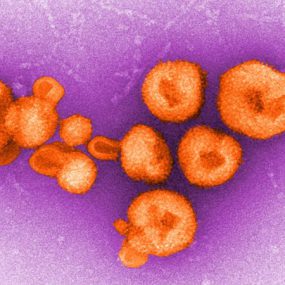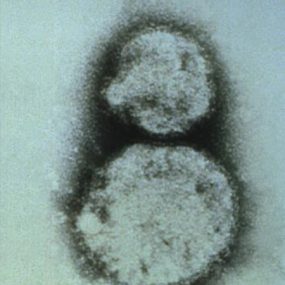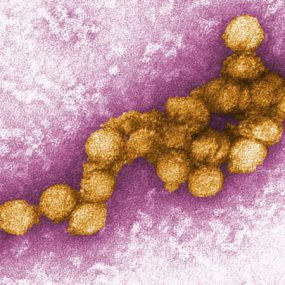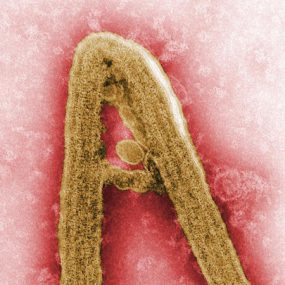What are VHFs?
Viral hemorrhagic fevers (VHFs) are a group of diseases that are caused by several distinct families of viruses. The term “viral hemorrhagic fever” refers to a condition that affects many organ systems of the body, damages the overall cardiovascular system, and reduces the body’s ability to function on its own. Symptoms of this type of condition can vary but often include bleeding, or hemorrhaging. Some VHFs cause relatively mild illness, while others can cause severe, life threatening disease. Most VHFs have no known cure or vaccine.
Although VHFs are caused by several families of viruses, these viruses share some common characteristics:
- They are RNA viruses, meaning viruses that have ribonucleic acid (RNA) as their genetic material. These viruses are the most common cause of emerging disease in people because RNA viruses change over time at a high rate.
- They are covered, or enveloped, in a lipoprotein outer layer, making it easier to destroy these viruses with physical (heat, sunlight, gamma rays) and chemical (bleach, detergents, solvents) methods.
- They naturally exist in animal or insect populations, referred to as host populations, and are generally restricted to the geographical areas where the host species live.
- They spread to people when a person encounters an infected animal or insect host. After the initial spread into the human population, some VHF viruses can continue to spread from person-to-person.
- Outbreaks of VHFs in people can be difficult to prevent since they can occur sporadically and cannot be easily predicted.
VHF diseases by virus family
VHF Virus Family
VHF Virus Family
VHF Diseases
VHF Diseases
Arenavirus (order Bunyavirales)
Arenavirus (order Bunyavirales)
Hantavirus (order Bunyavirales)
Hantavirus (order Bunyavirales)
Nairovirus (order Bunyavirales)
Nairovirus (order Bunyavirales)
Phenuivirus (order Bunyavirales)
Phenuivirus (order Bunyavirales)
VHF Challenges
More of the world’s population is at risk for VHFs
The number of viruses known to cause disease in humans around the globe is ever-increasing, and the way VHF viruses spread is likely to shift due to globalization, international travel, and climate change. Discovery and exploration of viruses and their hosts is necessary to limit global spread and disease burden.
Person-to-person transmission of some VHFs can occur
VHF viruses can spread to people when they come in contact with infected animals or insects. For many VHFs, person-to-person transmission can then continue, often through direct contact or in healthcare facilities without adequate infection control procedures. Further research on disease ecology can help scientists understand, and ultimately control, patterns and processes of virus transmission.
Confirmation of VHF cases can take time
Underdeveloped laboratories cannot rapidly diagnose and confirm illnesses, leading to delays in isolating infected people. Fast and accurate diagnostics are vital during outbreaks to confirm VHF cases, leading to faster isolation of cases and ultimately shorter, less severe outbreaks. Improving VHF diagnostic techniques to make them faster, more accurate, and easier to produce and use is an essential component to controlling these diseases.
Prevention of VHF outbreaks is difficult
Outbreaks of VHFs occur sporadically and irregularly, and their occurrence can be difficult to predict. Prevention is more difficult when the animal host is unknown or challenging to control (such as rodents or ticks). Strong risk communication and health education efforts are required, focusing on exposure prevention for communities and infection control for healthcare providers.
Availability of vaccines and treatments are limited
With limited effective vaccinations or drug treatments available, some VHFs are treated only with basic medical care, which is not always adequate to prevent virus spread and save lives. It is important to understand how the virus infects and spreads within the body to help guide the development of treatments and new strategies to protect against infection.



